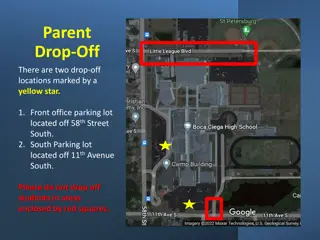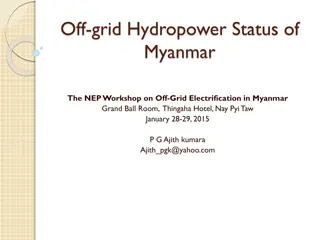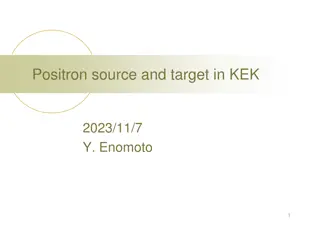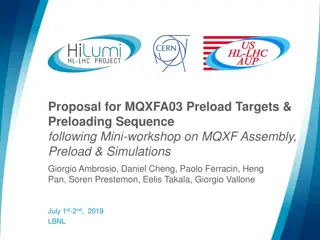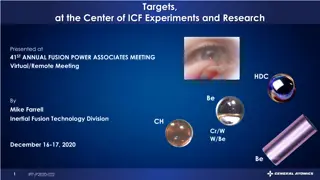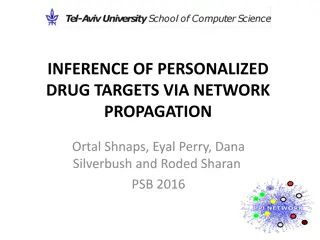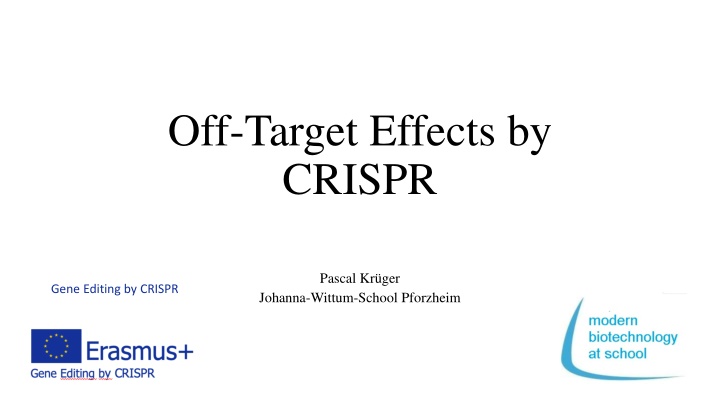
Off-Target Effects in CRISPR Gene Editing
Learn about off-target effects in CRISPR gene editing, caused by misbinding of gRNA with non-target DNA, leading to additional mutations and genomic instability. Explore strategies like extending PAM-sequence for higher specificity and the use of dCas9 mutants to minimize off-target effects while leveraging CRISPR advantages.
Download Presentation

Please find below an Image/Link to download the presentation.
The content on the website is provided AS IS for your information and personal use only. It may not be sold, licensed, or shared on other websites without obtaining consent from the author. If you encounter any issues during the download, it is possible that the publisher has removed the file from their server.
You are allowed to download the files provided on this website for personal or commercial use, subject to the condition that they are used lawfully. All files are the property of their respective owners.
The content on the website is provided AS IS for your information and personal use only. It may not be sold, licensed, or shared on other websites without obtaining consent from the author.
E N D
Presentation Transcript
Off-Target Effects by CRISPR Pascal Kr ger Gene Editing by CRISPR Johanna-Wittum-School Pforzheim
Off-target effects Off-target effects are caused by misbinding of the gRNA with non- target DNA Off-target effects cause additional mutations in the genome These can lead to genomic instability For example, different gRNA-structures can have a different influence on the DNA These target-sites are then split into on and off-target sites
Off-target effects 17 bp gRNA + Cas9 20 bp gRNA + Cas9 3 NGG 5 NGG Double- stranded DNA CRISPR/Cas9 Off-target cut CRISPR/Cas9 On-target cut 3 5 On-targetarea Off-target area
Length and specificity The PAM-sequence activates Cas9 to cut the DNA target sequence The PAM-sequence for Cas9 is NGG N means a position on target DNA which is variable and could be A, T, C or G PAM could be AGG, TGG, GGG CGG
Length and specificity of the PAM-sequence Extending the PAM-sequence to 5 bp reduces the number of possible binding sites This increases the specificity This happens because of mathematics: 43 = 64 45 = 1024 A longer PAM-sequence increases the specificity of the CRISPR/Cas- complex and therefore ensures fewer binding sites
What is the advantage of a longer PAM-sequence? The extension of the PAM-sequence ensures a higher specificity of the CRISPR/Cas-complex The extension reduces the possible off-target effects The longer PAM-sequnce can reduce the number of off-target effects
The use of dCas9 dCas9 = dead Cas9 Dead Cas9 is a mutant of Cas9 dCas9 can only lead to a single strand break There are also dCas9 mutants that no longer have any cutting function dCas9 is used, for example, to bring transcription factors to a desired gene location This way, one can use the advantage of CRISPR/Cas9 without actually cutting the target sequence
The use of dCas9 Two dCas9 proteins are required to induce a double-strand break using dCas9 Both also need one gRNA structure two in total A slightly offset double-strand break occurs When an off-target cut occurs, only a single-strand DNA break occurs These are easy and quick to repair
gRNA + dCas9 20 bp gRNA + dCas9 5 NGG 5 dCas 9 single-strand break Double-stranded DNA 3 3 NGG dCas 9 single-strand break 20 bp gRNA + dCas9
How do you design a gRNA? In science, programs are used that design gRNA for the planned CRISPR/Cas9 cut In the program you can also see the statistical probability of off- target effects Since each gRNA is programmable, you have to enter various information about the planned cut in the program
gRNA-Design with the help of CRISPOR First: you type in to the program, the sequence you want to use This sequence can not be longer then 2300 bp It has to be an exon-sequence Our sequence is 600 bp long Second: you select the target genome
gRNA-Design with the help of CRISPOR In the second step you choose the PAM sequence you want to use The program has a pool of PAM sequences These are composed of gRNA+PAM sequence
gRNA-Design with the help of CRISPOR The program indicates the length of the entered sequence The cut is expected at -3 bp from the PAM sequence You now get a list of the most effective gRNA sequences
gRNA-Design with of CRISPOR The program indicates all statistically possible off-target effects In our most effective gRNA, there is a possible off-target effect of 4 mismatches This is a very good gRNA Can also look different
gRNA-Design with CRISPOR (0-0-0-0-14) 1 missmatches = 100% match 2 missmatch = 100% match 3 missmatches = 100% match 4 missmatches = 100% match 5 missmatches = 14 Off-target-effects If 16 bases on the genome bind with the gRNA, 14 possible off-target effects can arise






